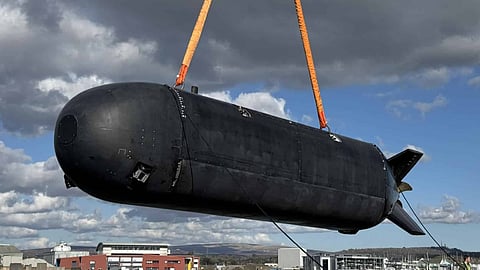VESSEL REVIEW | XV Excalibur – UK Royal Navy's new large unmanned submarine to serve as technology testbed
UK-based subsea craft manufacturer MSubs recently handed over a new prototype extra-large unmanned undersea vehicle (XLUUV) to the Royal Navy.
The unmanned submersible XV Excalibur was developed as part of the Royal Navy’s Project Cetus, which was initiated with the aim of mitigating the risks related to the operation of large unmanned undersea vehicles (UUVs) and their specialised payload.
With a length of 12 metres (39 feet), a beam of 2.2 metres (7.2 feet) and a displacement of 25 tonnes at full load, it is the largest UUV acquired by the Royal Navy to date.
Excalibur will serve as a testbed for maritime technology, both exploiting the natural intelligence surveillance and reconnaissance and stealth aspects of the craft itself alongside its ability to carry bespoke payloads. However, the XLUUV will be used exclusively as a demonstrator and will therefore not be deployed on operational missions.
The XLUUV’s size allows it to be transported worldwide via standard shipping container. According to the UK Ministry of Defence, the craft is designed to operate with all Royal Navy surface ships as well as those of the navies of allied nations.
Capable of deep-diving, long-endurance missions
Propulsion is by electric motor linked to battery packs mounted on the outside of the hull. The propulsion can deliver a range of 1,000 nautical miles and allow the XLUUV to dive deeper than even some of the manned submarines in the current Royal Navy fleet. Alternatively, the propulsion will enable the XLUUV to stay out at sea for five days.
A payload bay is fitted at the centre of the craft. Situated between the fore and aft pressure vessels, this bay can be fitted to carry mines, smaller UUVs, and sensors.
Because of the XLUUV’s modular construction, an optional additional payload bay can be inserted, increasing the carrying capacity of the craft and allowing the fitting of extra battery packs to further increase its range.
Unmanned systems specialist MarineAI is responsible for the autonomy software on board Excalibur, providing tactical routing, situational awareness and executive control of the vessel’s actuators and electrical systems. This makes the XLUUV capable of three-dimensional obstacle avoidance, while continuous communication with support vessels during a mission will enable fully informed autonomous decision-making.
Continuous testing to determine optimal applications of unmanned systems
Over the next two years, Excalibur will carry out extensive sea trials to help develop a better understanding of the unique challenges that come with operating uncrewed vessels of this size – with the aim of future vessels working alongside crewed platforms.
The navy said the trials and testing will contribute significantly to its constant efforts to remain ahead of potential undersea adversaries, safeguarding key infrastructure, protecting British and allied ships and submarines, and gathering intelligence.
According to Commodore Marcus Rose, Deputy Director Underwater Battlespace Capability, the lessons learnt from the programme will build on the navy’s experience from existing programmes, such as the mine hunting capability programme, to inform more extensive use of these technologies in a mixed force of crewed and uncrewed systems.
The name Excalibur was chosen partly in honour of an experimental high-speed submarine that was trialled by the Royal Navy in the 1950s and 1960s. The project to build the XLUUV has an estimated total cost of £15.4 million (US$20.1 million), which is funded by the navy’s Anti-Submarine Warfare Spearhead program.


